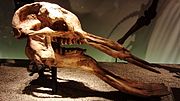| Amebelodontidae Temporal range: Early Miocene–Late Miocene PreꞒ Ꞓ O S D C P T J K Pg N | |
|---|---|

| |
| Platybelodon skeleton in a Hubei, China, museum | |
| Scientific classification | |
| Domain: | Eukaryota |
| Kingdom: | Animalia |
| Phylum: | Chordata |
| Class: | Mammalia |
| Order: | Proboscidea |
| Clade: | Elephantida |
| Family: | †Amebelodontidae Barbour, 1927 |
| Genera | |
| |
Amebelodontidae is an extinct family of large herbivorous proboscidean mammals related to elephants. They were formerly assigned to Gomphotheriidae, but recent authors consider them a distinct family. They are distinguished from other proboscideans by having flattened lower tusks (leading to the nickname "shovel tuskers") and very elongate mandibular symphysis. The lower tusks could grow to considerable size, with those of Konobelodon reaching 1.61 metres (5.3 ft) in length. Their molar teeth are typically trilophodont (with only Konobelodon being fully tetralophodont), and possessed posttrite conules. In the past, amebelodonts' shovel-like mandibular tusks led to them being portrayed scooping up water plants, however, dental microwear suggests that they were browsers and mixed feeders. The lower tusks have been proposed to have had a variety of functions depending on the species, including stripping bark, cutting through vegetation, as well as possibly digging. They first appeared in Africa during the Early Miocene, and subsequently dispersed into Eurasia and then North America. They became extinct by the beginning of the Pliocene. While some phylogenetic studies have recovered Amebelodontidae as a monophyletic group that forms the sister group to Gomphotheriidae proper, some authors have argued that Amebelodontidae may be polyphyletic, with it being suggested that the shovel-tusked condition arose several times independently within Gomphotheriidae, thus rendering the family invalid.
Phylogeny of Amebelodontidae after Li et al. 2023.
| Elephantida (gomphotheres sensu lato) |
| ||||||||||||||||||||||||||||||||||||||||||||||||||||||||||||||||||||||||||||||||||||
Gallery
References
- ^ Wang, Shi-Qi; Deng, Tao; Ye, Jie; He, Wen; Chen, Shan-Qin (3 August 2017). "Morphological and ecological diversity of Amebelodontidae (Proboscidea, Mammalia) revealed by a Miocene fossil accumulation of an upper-tuskless proboscidean". Journal of Systematic Palaeontology. 15 (8): 601–615. Bibcode:2017JSPal..15..601W. doi:10.1080/14772019.2016.1208687. S2CID 89063787.
- Mothé, Dimila; Ferretti, Marco P.; Avilla, Leonardo S. (12 January 2016). "The Dance of Tusks: Rediscovery of Lower Incisors in the Pan-American Proboscidean Cuvieronius hyodon Revises Incisor Evolution in Elephantimorpha". PLOS ONE. 11 (1): e0147009. Bibcode:2016PLoSO..1147009M. doi:10.1371/journal.pone.0147009. PMC 4710528. PMID 26756209.
- Larramendi, Asier (2023-12-10). "Estimating tusk masses in proboscideans: a comprehensive analysis and predictive model". Historical Biology: 1–14. doi:10.1080/08912963.2023.2286272. ISSN 0891-2963.
- ^ Konidaris, George E.; Tsoukala, Evangelia (2022), Vlachos, Evangelos (ed.), "The Fossil Record of the Neogene Proboscidea (Mammalia) in Greece", Fossil Vertebrates of Greece Vol. 1, Cham: Springer International Publishing, pp. 299–344, doi:10.1007/978-3-030-68398-6_12, ISBN 978-3-030-68397-9, retrieved 2023-03-25
- Lambert, W.D (1992). "The feeding habits of the shovel-tusked gomphotheres: evidence from tusk wear patterns". Paleobiology. 18 (2): 132–147. Bibcode:1992Pbio...18..132L. doi:10.1017/S0094837300013932. JSTOR 2400995.
- Semprebon, Gina; Tao, Deng; Hasjanova, Jelena; Solounias, Nikos (2016). "An examination of the dietary habits of Platybelodon grangeri from the Linxia Basin of China: Evidence from dental microwear of molar teeth and tusks". Palaeogeography, Palaeoclimatology, Palaeoecology. 457: 109–116. Bibcode:2016PPP...457..109S. doi:10.1016/j.palaeo.2016.06.012.
- Baleka, Sina; Varela, Luciano; Tambusso, P. Sebastián; Paijmans, Johanna L.A.; Mothé, Dimila; Stafford, Thomas W.; Fariña, Richard A.; Hofreiter, Michael (January 2022). "Revisiting proboscidean phylogeny and evolution through total evidence and palaeogenetic analyses including Notiomastodon ancient DNA". iScience. 25 (1): 103559. Bibcode:2022iSci...25j3559B. doi:10.1016/j.isci.2021.103559. PMC 8693454. PMID 34988402.
- Lambert, W. David (2023-10-02). "Implications of discoveries of the shovel-tusked gomphothere Konobelodon (Proboscidea, Gomphotheriidae) in Eurasia for the status of Amebelodon with a new genus of shovel-tusked gomphothere, Stenobelodon". Journal of Vertebrate Paleontology. doi:10.1080/02724634.2023.2252021. ISSN 0272-4634.
- Li, Chunxiao; Deng, Tao; Wang, Yang; Sun, Fajun; Wolff, Burt; Jiangzuo, Qigao; Ma, Jiao; Xing, Luda; Fu, Jiao (2023-11-28), "Longer mandible or nose? Co-evolution of feeding organs in early elephantiforms", eLife, 12, doi:10.7554/eLife.90908.1, retrieved 2024-05-29
| Genera of the order Proboscidea | ||||||||||||||||||||||||||||||
|---|---|---|---|---|---|---|---|---|---|---|---|---|---|---|---|---|---|---|---|---|---|---|---|---|---|---|---|---|---|---|
| ||||||||||||||||||||||||||||||
| 
 | |||||||||||||||||||||||||||||
| Taxon identifiers | |
|---|---|
| Amebelodontidae | |
This article about a prehistoric proboscidean is a stub. You can help Misplaced Pages by expanding it. |


